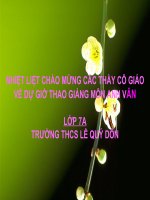Unit 16. The wonders of the world
Bạn đang xem bản rút gọn của tài liệu. Xem và tải ngay bản đầy đủ của tài liệu tại đây (2.67 MB, 28 trang )
1. The Grand Canyon
(United States of America)
2. The Panama Canal
(Panama)
3. The Clock Tower (Big Ben)
(United Kingdom)
4. The Roman Colosseum
(Italy)
5. The Lighthouse
of Alexandria
(EGYPT)
6. The Hanging Gardens
of Babylon
(Iraq)
7. The Great Wall
(China)
8. Taj Mahal
(India)
9. The Great Barrier Reef
(Australia)
Unit 16:
The Wonders of the
World
(Listening)
Fill in the blank with one suitable word from the box
Dynasty
defence
man-made
World Natural
Heritage
ancient
significance
UNESCO
magnificent
symbol
province
1. .........................
UNESCO stands for the United Nations Educational, Scientific and Cultural
Organization.
World Natural
province was recognized as a .........................
2. Ha Long Bay, situated in Quang Ninh .........................,
Heritage
Site in 1994 for the first time.
3. Established as the Capital of Vietnam in 1802, Hue was not only the political but also the
cultural and religious centre under the Nguyen .........................
Dynasty until 1945.
ancient
4. Hoi An .........................
town lies in Quang Nam Province, 30 km from Da Nang.
magnificent brick temples of My Son Sanctuary are the great .........................
symbol
5. The .........................
of
human’s efforts, intelligence and spiritual power.
6. Affected by massive tectonic changes, Phong Nha-Ke Bang National Park’s Karst landscape is
significance
extremely complex with many geomorphic features of considerable .........................
7. Vietnam’s history can be divided into 3 main periods: Northern Kingdom’s domination (208
defence for independence (939 - 1945) and
B.C - 939 A.D), national construction and .........................
national independence and socialism (since 1945)
man-made wonders of the
8. Machu Picchu, the lost city of the Incas, is among the top 10 .........................
world.
Listen to the Tape
Listen to the tape and fill
in the missing
information:
Attraction of the wall
It is said to be visible from (1)
the_________.
moon
It was listed as a World Heritage by UNESCO in
(2)1987
_________.
Construction of the wall
-
It was mostly built during (3) _________________.
The Ming
It took (4) _________ years to complete
the wall.
Dynasty
200
Some of its parts were built around (5)
200 B.C
_________.
Special
features of
the wall
-
6,000
The length of the wall is (6) _______________.
kilometres
11
The average height of the wall
is (7) _________.
metres
The ancient people used (8) stones
_________
to build
the roadway.
Listen again and answer
the following questions:
1. When did the ancient Chinese start building the
Great Wall?
In 1368.
2. How many provinces does the wall cover?
Five
3. provinces.
Why it is considered one of the greatest manmade wonders in the world?
Thanks to its magnificence and significance.
4. Which part of the wall is the best choice for visit?
Why?
The Northwest of Beijing for it is still in its original
state.
L
u
c
k
y
1
2
3
4
5
6
7
8
9
N
u
m
b
e
r
s
Prepare writing lesson
Question 1:
Was the Great Wall of China listed as
a World Heritage by UNESCO in 1978?
No, it wasn’t. It was listed as a
World Heritage by UNESCO in
1987.
Lucky
number
Question 2:
When did the ancient Chinese start
building the Great Wall?
In 1368.
Question 3:
How long did it take to complete
the wall?
200 years.
Question 4:
How many provinces does the
wall cover?
Five provinces.
Question 5:
Is the Great Wall of China said to be
visible from the moon?
No, it isn’t.
Lucky
number
Question 6:
How long is the
wall?
6,000 kilometres.









